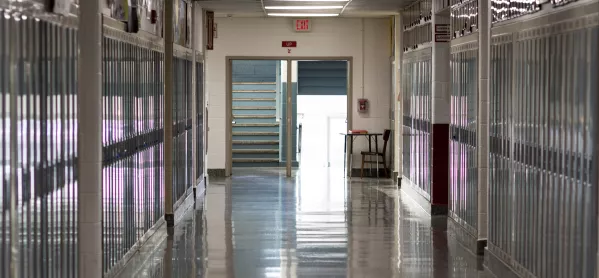Could ‘silent corridors’ work at your school?

The concept of silent corridors first found its way on to my radar two years ago, before all the upheaval of Covid and teacher-assessed grades.
For a while it created a bit of a buzz on social media, with teachers taking sides on whether it made sense to ask students to be silent as they moved around the school.
At the time, I thought it was a ridiculous idea - we already require students to be quiet in lessons all day, and now we were going to ask them to be silent in between lessons, too. When were students supposed to interact with their friends, have a breather and relax if they were always trying to keep silent?
Read more:
- Behaviour: Why points systems are worse than pointless
- ‘Think twice before ”punishing” a pupil’
- Why now is the time to change your seating plan
Fast forward 24 months, and I’m now a complete convert. What changed my mind? For one thing, I moved schools. For another, we had to face the small matter of a global pandemic.
In my new school, we initially introduced silent corridors as part of our health and safety regulations, as a way to reduce aerosol transmission and make the confined spaces of school corridors safer.
Behaviour: Do silent corridors work?
This was the reason we put the strategy in place, but what really changed my opinion of it was the knock-on effects that it seemed to have on behaviour in lessons.
We all know how important those first few minutes in the lesson are. Getting students through the door and occupied with a starter task, all the while dealing with any issues with equipment and so forth.
When these first few minutes go wrong, it can be hard to regain control of the lesson. If time gets wasted at the start, this can have a negative impact on students’ levels of focus, engagement and productivity for the whole lesson.
Once we introduced silent corridors, I found that this simply didn’t seem to be the issue that it once was. Suddenly there weren’t any conversations that I needed to ask students to end at the door, no little squabbles that had been going on in the corridor spilling into my classroom. Instead, every lesson is guaranteed a focused and silent start.
And there is another bonus for anyone who works in a school with a split timetable (as I do). One of the most frustrating things with this arrangement is that other year groups moving around the school - changing lessons or going on break and lunch - often create a huge amount of noise that disturbs your lesson.
Again, with silent corridors, this issue goes away. There are no longer any interruptions halfway through a lesson, and there is no need to quickly go and close the door to allow your students to keep working away peacefully.
Tips for introducing silent corridors in schools
If this all sounds appealing, you might be wondering how you could make it work in your own school. So, how should you go about implementing a policy of silent corridors? There are two key points you need to consider.
Firstly, I think it is crucial that students understand why you’re doing it. If that reason is to support teaching and learning through smoother lesson starts, that is fine. But you need to explain this to the students. If students don’t understand why they are being asked to do something, then they are far less likely to comply.
As with any new system, you will need to consider the sanctions that you will apply if students do not follow the requirements. These need to be consistent across the school.
In this instance, I would recommend a pragmatic approach. If you punish a student every single time they so much as utter a word, detentions are going to get rather full. Yet students who are extremely loud or have little care for the new system need to face the consequences. Make sure all staff are on the same page about the sanctions to apply, and when to apply them.
There are numerous reasons why silent corridors are beneficial. But for me, and my classroom teaching, the key benefit has been that they have really helped to support strong lesson starts and avoid disruption, even where students haven’t meant to cause issues.
Nathan Burns is an assistant progress and achievement leader for key stage 3, as well as a maths teacher
You need a Tes subscription to read this article
Subscribe now to read this article and get other subscriber-only content:
- Unlimited access to all Tes magazine content
- Exclusive subscriber-only stories
- Award-winning email newsletters
Already a subscriber? Log in
You need a subscription to read this article
Subscribe now to read this article and get other subscriber-only content, including:
- Unlimited access to all Tes magazine content
- Exclusive subscriber-only stories
- Award-winning email newsletters
